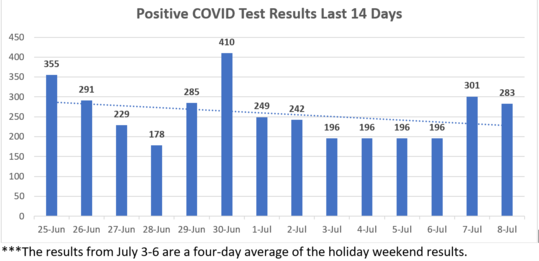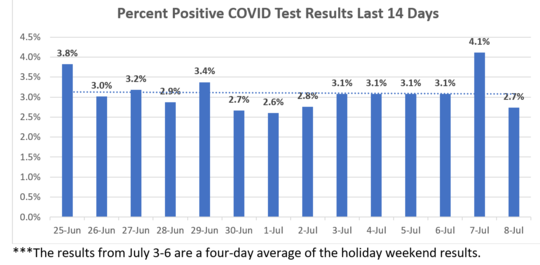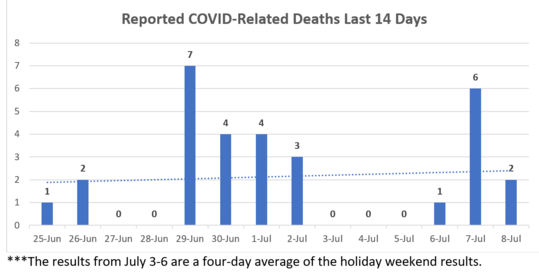|
July 8, 2021
Dear Neighbors and Friends,
I hope that you and your loved ones are doing well, staying healthy, and looking out for your neighbors and friends in these ever-challenging times.
I’m happy to report that for the state as a whole, our COVID picture continues to improve. Right after last week’s newsletter went out, OHA and the Governor announced that we had met the goal of 70% of adults (18+) having received at least one dose of the COVID vaccine. It was somewhat of a moot point, given that statewide restrictions had already been lifted at the end of June. Still, it’s a noteworthy achievement, one reached by only a handful of states.
As you’ll see from today’s reported metrics, the weekly reports, the County-by-County report, and the recently-released epidemiological forecast, new cases, hospitalizations, and test positivity rates continue their overall decline, and death rates remain low. However, you’ll see that some parts of the state are continuing to see lower vaccination rates, and consequently higher infection rates.
You'll also find the updated numbers of variant cases here in Oregon. As you'll see, the number of cases of the worrisome delta variant remains low here.
I’ve provided links to a number of articles that have come out over the last week that help us understand different aspects of the current COVID situation, here and in other parts of the country and world.
I’m also providing info on another set of bills that were passed in the recently-completed legislation session, those focused on Energy and the Environment.
As you’ll see below, tomorrow afternoon the Governor will be announcing the winner of the $1 million lottery. I hate to break the news to you, but if you haven’t yet learned that you’re the big winner, you’re not. Whoever the lucky person is, they know already and will be appearing with the Governor tomorrow. However, there are still a number of prizes to be awarded in future weeks.
And if you ARE the big winner, CONGRATULATIONS!
Until next week, please stay safe and let me know if you have any questions about information in tonight’s newsletter.
TODAY’S CORONAVIRUS AND CORONAVIRUS RESPONSE UPDATE
-
New COVID Cases: OHA reports 212 new COVID cases today. That’s an average of 196 per day for the 7 days since the last newsletter (26 more per day than the previous week). The cumulative number of cases in Oregon since the beginning of the pandemic is 209,973.
-
Variant COVID Cases: Here are this week’s updated case counts for the COVID variants in Oregon, cumulative from the beginning of the pandemic (released on Wednesday). Be advised, though, that not all positive tests are being sequenced for variants, so the numbers are likely higher.
- 1,786 (up from 1,715) cases of the B.1.1.7 (formerly known as the U.K. variant, now called the Alpha) variant,
- 389 cases (up from 362) of the P.1 (formerly Brazilian, now Gamma) variant,
- 152 (up from 151) cases of the B.1.351 (formerly South African, now Beta) variant.
- In addition, we are now seeing 1,128 (down from 1,130) cases of the B.1.427/B.1.429 variant (Epsilon) and
- 14 cases (up from 13) cases of the new B.1.617.2 (Delta) variant.
- OHA’s Variant Dashboard also providing current variant case numbers for different parts of the state. It’s updated each Wednesday.
-
Positive Test Results: OHA reported 283 positive tests today. That’s an average of 230 per day for the seven days since the last newsletter (40 fewer per day than the previous week). The cumulative total of positive test results since the beginning of the pandemic is now 304,397.
-
Total Tests: OHA reported an additional 10,359 tests today. That’s an average of 7,419 per day for the seven days since the last newsletter (1,949 fewer than the last newsletter). Our cumulative total of reported tests is 5,482,200.
-
Positivity Rate: The test positivity ratio for Oregon today is again 2.7%. That’s an average of 3.1% per day for the seven days since the last newsletter (0.1% more than last week).
-
Hospitalization Information:
- Patients Currently with Confirmed COVID-19: 100 (34 fewer than last newsletter)
- ICU Patients Confirmed w COVID-19: 28 (1 more than last newsletter).
- Available ICU Beds: 145 (14 more than last newsletter)
- Other Available Beds: 435 (8 fewer than last newsletter).
- Confirmed COVID-19 Patients Currently on Ventilators: 14 (2 fewer than last newsletter)
- Available Ventilators: 795 (2 more than last newsletter).
-
Deaths: I’m sorry to report 2 additional COVID deaths today, twelve more than last week. That’s an average of 1.7 per day for the five days since the last newsletter (vs. 3 per day the previous week). The total number of COVID deaths in Oregon is 2,790.
-
Vaccinations:
- The 7-day running average is now 5,406 doses per day (down 2,108 from last week).
- Total First and Second Doses Administered So Far: 4,446,362
- 2,564,438 Pfizer doses
- 1,752,116 Moderna doses
- 172,177 Johnson & Johnson doses
- Total Oregonians vaccinated so far: 2,421,075
- 2,217,891 now fully vaccinated with two doses
- To date, 5,510,085 doses of vaccine have been delivered to sites across Oregon. (That’s 13,030 more than last week.)
- 80.7% of these doses have been administered so far. The national average is now 86.2%.
- 59.3% of Oregonians have received at least one dose (66.7% of those 16 and older).
- 54.4% of Oregonians are now fully vaccinated (61.4% of those 16 and older).
- For more details, including the demographics of those receiving the vaccine and the number of vaccinations by county, go to the OHA vaccinations dashboard.
-
Bloomberg News provides a wealth of easy-to-read information on the trajectory of vaccinations—by state, nationally, and internationally.
Additional Brief Updates
- The Oregonian is also replacing its daily COVID reports with a weekly summary. However, daily numbers will continue to be reported on its online site when the OHA releases them (i.e., not on the weekends). Here's more.
- As you’ll see above, it doesn’t appear that the Delta variant has begun to take hold in Oregon yet. However, it clearly is in other parts of the U.S. and the world, and that’s raising a great deal of concern. The answer? Vaccinations. The latest evidence is showing that the major vaccines provide strong immunity from the delta virus—but only if both doses are taken. Here’s reporting on a new study published in Nature.
- There’s a troubling correlation between low-income Medicaid recipients and low vaccination rates. This is a real problems, as this population includes many whose pre-existing conditions make them particularly vulnerable to severe impacts of infection. Experts are exploring strategies designed to target and reach the low-income in greater numbers. Here's more.
- A new study using Fitbit wearers to collect heartrate data is revealing some of the ongoing effects of COVID on those who've been infected.
- Newly-eligible teens (actually 12+) have been getting vaccinated at rates higher than those who have been eligible for some time. It’s not clear whether that will continue after the initial wave of vaccinations of this group or if they will follow the same pattern as we saw in adults (with steady reductions in new vaccinations). If the latter, that would be a big mistake according to a group of prominent physicians writing in the New York Times. They show why any risks from the vaccine are greatly outweighed by the benefits. The same will be true when younger children become eligible.
- An opinion piece in today’s Washington Post targets what it calls "right-wing anti-vaccine hysteria," designed to exploit vaccine hesitancy for political purposes.
- Despite the overall politicization of the issue of vaccinations in this country, some GOP governors are imploring their constituents to get vaccinated.
- Though the CDC has not yet agreed to this, some European countries are encouraging those with compromised immune response to get a third dose of the vaccine. Here's more about why that may be a good idea.
- A recent study shows the large extent to which birthday parties have been the source of COVID spread during the pandemic.
- The Oregon Employment Department has released a lengthy study on the disparate impacts of the pandemic on Oregon workers and industry sectors. There’s also a podcast version.
- Here a story from OPB about plans the colleges and universities are making for fall quarter. Some are requiring vaccinations, others not. Some are continuing distancing requirements, others not.
- On a non-COVID topic, here’s an interesting story from Pamplin Media with information about what’s on the Legislature’s agenda between now and the Redistricting Special Session on September 20.

Governor Will Announce Million Dollar Lottery Winner Tomorrow
Tomorrow, Governor Kate Brown will announce the $1 million winner of the Take Your Shot, Oregon campaign in a live broadcast at 1:30pm. She will be joined by representatives from the Oregon Lottery and the Oregon Health Authority, as well as the winner and their family. You can watch the announcement on YouTube, with an American Sign Language simulcast. A Spanish language simulcast will be available on OHA's Facebook page. Additional winners of state and county Take Your Shot, Oregon prizes will be announced in the coming weeks as winners are notified.
Oregon OSHA Releases Temporary Rules for Workplaces During Heat Emergencies
Last week’s heat crisis was another one of those wake-up calls that should prompt us to update our rules and regulations in the face of increasing numbers of climate emergencies. As I write this, the death toll from last week’s crisis is at 116, and that includes at least three who were deemed to have died as a result of work. One was a farmworker originally from Guatemala, Sebastián Francisco Perez, whose death was widely reported. In a conversation with the Oregon OSHA Director, I learned that a dairy worker and a worker at a distribution facility have also died of heat-related causes.
It’s clear that we need clarification of the rules governing workplace safety during heat events. Oregon OSHA has already been engaged in writing new permanent rules regarding exposure to smoke. Some of us have called on them to draft temporary (i.e., emergency) rules for heat events, and have been joined in that by the Governor. As a result of that, with engagement from worker advocates and industry representatives, a set of temporary rules have been created.
Those rules were released to the public this morning. Here they are. As you’ll see, they specify requirements to be met when the heat index in the workplace (indoors or outdoors) is above 80 degrees and further requirements when the heat index is above 90 degrees. You can find more information about the triggering heat levels here.
The temporary rules will be in place for 180 days. After that, they will need to be replaced by permanent rules, so that rulemaking process will continue, taking advantage of the lessons learned from the temporary rules.
Still, it’s clear to many of us that a more comprehensive legislative approach will be needed. For example, the rules don’t address the difficult issue of farmworker housing. Much of the housing stock (including trailers) is inadequate to keep indoor temperatures below 90 degrees when it’s over 100 outdoors, which creates real risk for workers who need rest. It’s especially dangerous when those 100+ temperatures last over multiple days, which appears to be increasingly likely. The rules also don’t specify when work must stop entirely for the sake of worker safety. Oregon OSHA apparently does not have the authority to order work to be stopped, even under extreme conditions—it must be given that authority by the Legislature.
In order to work on these broader issues, a legislative work group will be convened under the leadership of Representatives Ricki Ruiz and Teresa Alonso Leon, both of whom have close relatives who work in the fields. I’ll be part of that and will let you know how it’s going. Please send me your ideas and questions.
2021 Legislative Session in the Rearview Mirror: Energy & Environment
In many respects, the 2021 session was the most successful we’ve had for quite a while. Along with work that is happening as a result of the Governor’s Climate Action Executive Order, we are seriously doing our part to help move the nation address the climate crisis (which seems more evident with each passing day). Several important bills were passed to help reduce our greenhouse gas emissions from electricity, transportation, and buildings.
A bill creating a major overhaul of our recycling system was also passed, as was a big bill aimed at reducing the risk of wildfires. Not much, unfortunately, happened on the forestry front, though the Senate did confirm some new appointments to the Board of Forestry that have moved the board towards a more balanced perspective (i.e., balancing industry interests and environmental interests).
We are also seeing increased stresses on our water supply and on water quality. One of the most noteworthy accomplishments of this session has been significant investment (nearly $700 million) in long-delayed water infrastructure projects, as well as monitoring and planning for an adequate supply of groundwater.
Here's a comprehensive list of the energy/environment bills that passed, along with a few of those that didn’t (aka bills for another day).
OHA Releases Latest County Metrics
Though it’s no longer assigning risk levels to counties, OHA is still reporting weekly increases/decreases in COVID spread for each county and for the state as a whole. Some of the counties are seeing increases, though their overall rates remain relatively low, while most continue to decline. The state as a whole continues to see declining cases and positivity rates. We continue to see a general correlation between county vaccination rates and county case rates.
Weekly COVID Data and Outbreaks Report Released: Further Declines
The Oregon Health Authority’s COVID-19 Weekly Report, released this afternoon, shows a continued decrease in daily cases and hospitalizations.
- OHA reported 1,189 new daily cases of COVID-19 during the week of Monday, June 28, through Sunday, July 4. That represents a 13% decrease over the previous week and the lowest weekly count for more than a year.
- New COVID-19 related hospitalizations declined by 40%, to 66, from 110 the previous week.
- Unfortunately, there were 19 reported COVID-19 related deaths, up from seven reported the previous week. Some of those deaths, however, were from weeks and months ago, and even with them included, the numbers are lower than they were two weeks ago.
- There were 62,307 tests for COVID-19 for the week of June 27 through July 3, a slight increase from the previous week.
- The percentage of positive tests was 2.9%, another decline from the previous week’s 3.2%.
Today’s COVID-19 Weekly Outbreak Report shows 22 active COVID-19 outbreaks in senior living communities and congregate living settings.
1/13/21 202 facilities
2/10/21 116 facilities
3/10/21 44 facilities
4/14/21 24 facilities
5/12/21 42 facilities
6/09/21 19 facilities
6/16/21 22 facilities
6/23/21 21 facilities
6/30/21 21 facilities
7/8/21 22 facilities
The Outbreak Report also includes the latest data on COVID in workplaces, childcare centers, and public and private K-12 schools.
OHA Releases Latest Epidemiological Forecast
On Friday the OHA released its latest COVID-19 forecast, which projects fewer hospitalizations and daily cases through July 20.
The forecast was produced by OHA with support from the Institute for Disease Modeling in Seattle. It reflects information collected up to June 30. To account for delays in reporting, diagnosed cases with a specimen collection date after June 22 were not used; they used the same cutoff date for hospital admissions and deaths. In the epidemiological model, cases tested on June 22 reflect exposures that occurred around June 16.
According to the model, the effective reproduction rate — the expected number of secondary cases that a single case generates — was estimated at 0.74 through June 16.
That’s actually an increase from the previous estimate of 0.66. We are seeing higher daily case numbers than the previous forecast had envisioned, presumably as a result of lower-than-expected vaccination rates, combined with relaxing of COVID restrictions.
Still, even with that higher-than-projected Re level, cases continue to decline. (Anything under an Re of 1.0 should lead to a reduction in cases.)
if that 0.74 Re level of transmission continues over the next three weeks, daily cases will decline to approximately 115 cases per day (from the current 196), and new hospitalizations would drop to seven per day (vs. the current rate of 16 per day).
A second scenario projects that transmission could increase by 20%. Under that scenario, new cases will still continue to decline, but at a lower rate—to an average of 165 cases per day, and new hospitalizations would drop to 12 per day.
The report again stresses the importance of vaccination, even for those who have been previously infected. The modeling shows that estimated immunity from vaccination is present in four times as many people as those who have naturally acquired immunity (immunity stemming from prior infection).
People who have recovered from the disease and then are vaccinated develop a particularly high level of antibodies to protect that from further infection. OHA therefore recommends that people get the vaccine to increase their protection against COVID-19.
Nearly all COVID deaths now (99.2%) are among people who have not been vaccinated.
And the Deaths:
Here is information about the deaths that OHA has reported since the last newsletter on July 1. Again, you’ll see that some of them are late-reports from previous months.
Oregon’s 2,779th COVID-19 death is an 89-year-old man from Lincoln County who tested positive on Jan. 20 and died on Jan. 31 at Rockledge Regional Medical Center.
Oregon’s 2,780th COVID-19 death is a 92-year-old man from Marion County who tested positive on June 16 and died on June 29 at Salem Hospital.
Oregon’s 2,781st COVID-19 death is a 77-year-old man from Yamhill County who tested positive on Feb. 7 and died on Feb. 15 at South Bay Hospital.
Oregon’s 2,782nd death is a 63-year-old man from Douglas County who tested positive on May 23 and died on June 10 at Asante Three Rivers Medical Center.
Oregon’s 2,783rd COVID-19 death is a 49-year-old woman from Jefferson County who tested positive on June 15 and died on July 3 at St. Charles Bend Hospital.
Oregon’s 2,784th COVID-19 death is a 41-year-old man from Hood River County who tested positive on July 2 and died on July 4; location of death is being confirmed.
Oregon’s 2,785th COVID-19 death is an 87-year-old man from Lane County who tested positive on June 14 and died on July 3 at PeaceHealth Sacred Heart Medical Center Riverbend.
Oregon’s 2,786th COVID-19 death is a 52-year-old man from Josephine County who tested positive on June 18 and died on July 5 at Rogue Valley Medical Center.
Oregon’s 2,787th COVID-19 death is a 64-year-old man from Marion County who tested positive on April 24 and died on June 29 at Salem Hospital..
Oregon’s 2,788th COVID-19 death is an 83-year-old woman from Umatilla County who tested positive on June 18 and died on July 2 at Providence St. Mary Medical Center.
Oregon’s 2,789th COVID-19 death is a 66-year-old man from Multnomah County who tested positive on June 22 and died on July 6 at Legacy Emanuel Medical Center.
Oregon’s 2,790th COVID-19 death is a 72-year-old man from Klamath County who tested positive on June 23 and died on July 6 at Sky Lakes Medical Center.





Want to See Past Newsletters?
If there was COVID-related information in a past newsletter that you want to go back to, but find you’ve deleted it, you can always go to my legislative website (senatordembrow.com), click on “News and Information,” and you’ll find them all there. Also, if someone forwarded you this newsletter and you’d like to get it directly, you can sign up for it there.
AND FINALLY,
Here again are some resources that you will find useful
If the above links are not providing you with answers to your questions or directing you to the help that you need, please consider me and my office to be a resource. We’ll do our best to assist you or steer you in the right direction.
Best,
 Senator Michael Dembrow
District 23
email: Sen.MichaelDembrow@oregonlegislature.gov
web: www.senatordembrow.com
phone: 503-281-0608
mail: 900 Court St NE, S-407, Salem, OR, 97301
|